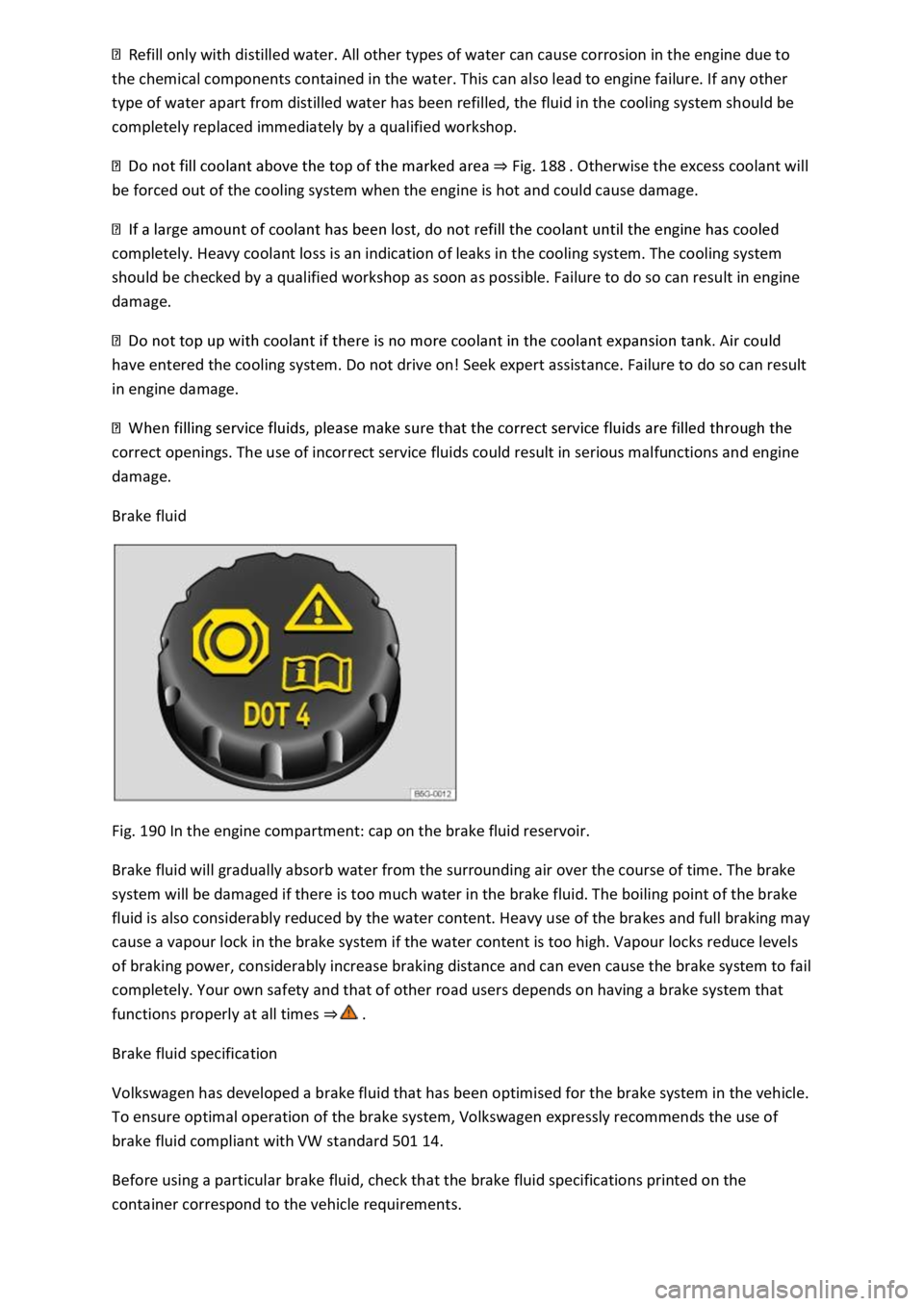Page 374 of 502
area Fig. 186otorway journeys in summer, when towing a
trailer Trailer towing
Checking the engine oil level and refilling the engine oil
Fig. 186 Engine oil level markings on the oil dipstick (variants).
Fig. 187 In the engine compartment: engine oil filler cap (illustration).
First read and observe the introductoryinformation and safety warnings
Key to Fig. 186
Engine oil level too high observe the messages on the instrument cluster display or contact a
qualified workshop, if necessary.
Do not fill engine oil.
Engine oil level OK.
Engine oil level too low fill engine oil.
Checklist
Carry out the steps in the specified order
Page 375 of 502

With the engine at operating temperature, park the vehicle on a level surface to ensure that the
engine oil reading is correct.
Switch off the engine and wait a few minutes for the engine oil to flow back into the sump.
Open the bonnet In the engine compartment.
Identify the engine oil filler cap and oil dipstick. The engine oil filler opening can be recognised by
the symbol on the cap and the oil dipstick has a coloured handle. If you cannot find the cap and
dipstick, please contact a qualified workshop.
Pull the dipstick out of the guide tube and wipe it off with a clean cloth.
Insert the oil dipstick into the guide tube again as far as it will go. If there is a marking on the upper
end of the oil dipstick, this marking must fit into the corresponding groove at the top end of the
guide tube upon insertion.
Engine oil
level too high. Observe any messages that are shown on the instrument cluster display or contact a
qualified workshop . Do not fill any engine oil . Continue with step 16. Engine oil level OK.
Engine oil can, e.g. in the case of high engine loads , be filled up to the upper limit of this range.
Continue with step 8 or 16. Engine oil level is too low. Engine oil must be filled. Continue with
step 8.
After reading off the oil level, push the oil dipstick back into the guide tube as far as it will go.
Unscrew the cap of the engine oil filler opening .
Using only the engine oil approved by Volkswagen expressly for this engine, fill oil gradually in small
amounts (no more than 0.5 l).
Page 376 of 502

engine oil to flow into the sump up to the marking on the engine oil dipstick.
Read the engine oil level from the dipstick again before refilling with a further small quantity of
engine oil. Never overfill engine oil .
After refilling, the engine oil level should be in the middle of area
area nd must not be in area .
If too much engine oil has been added unintentionally and the engine oil level is in area
start the engine. Inform a qualified workshop and seek expert assistance if necessary.
Close the engine oil filler opening with the cap after filling.
Insert the oil dipstick into the guide tube as far as it will go. If there is a marking on the upper end of
the oil dipstick, this marking must fit into the corresponding groove at the top end of the guide tube
upon insertion.
Close the bonnet In the engine compartment.
WARNING
Engine oil can ignite if it comes into contact with hot engine components. It can cause fires, burns
and other serious injuries.
up and ignite when the engine is running.
dipstick is properly inserted back into the guide tube. This will prevent the engine oil from draining
out on to hot engine components when the engine is running.
NOTICE
Fig. 186
necessary. The catalytic converter and the engine could otherwise be damaged.
Page 377 of 502

lfunctions and engine
damage.
The engine oil level must never be above area Fig. 186
the crankcase breather and escape into the atmosphere via the exhaust system.
Troubleshooting
First read and observe the introductoryinformation and safety warnings
and Engine oil pressure too low
The central warning lamp lights up red and the text message Stop vehicle. Oil pressure. Observe
vehicle wallet is displayed.
Do not drive on!
Switch off the engine and check the engine oil level. Checking the engine oil level Checking the
Do not drive on or allow the engine to run if the
warning lamp is flashing although the engine oil level is correct. The engine could otherwise be
damaged. Seek expert assistance.
and Engine oil level too low
The central warning lamp lights up red and the text message Refill engine oil. is displayed.
Engine oil level is too low. Switch off the engine.
Checking the engine oil level Checking the engine oil level and refilling the engine oil
and Engine oil level low
The central warning lamp lights up yellow and the text message Check oil level. is displayed.
Engine oil level is low. Switch off the engine.
Checking the engine oil level Checking the engine oil level and refilling the engine oil
and Fault in engine oil system
The central warning lamp lights up yellow and the text message Oil sensor: workshop. is displayed.
Engine oil system is faulty. Go to a qualified workshop and have the engine oil sensor checked.
and Engine oil level too high
The central warning lamp lights up yellow and the text message Reduce oil level. is displayed.
Engine oil level is too high. Switch off the engine.
Check the engine oil level. Checking the engine oil level Checking the engine oil level and refilling
the engine oil
Page 382 of 502

Refill only with distilled water. All other types of water can cause corrosion in the engine due to
the chemical components contained in the water. This can also lead to engine failure. If any other
type of water apart from distilled water has been refilled, the fluid in the cooling system should be
completely replaced immediately by a qualified workshop.
Fig. 188
be forced out of the cooling system when the engine is hot and could cause damage.
completely. Heavy coolant loss is an indication of leaks in the cooling system. The cooling system
should be checked by a qualified workshop as soon as possible. Failure to do so can result in engine
damage.
have entered the cooling system. Do not drive on! Seek expert assistance. Failure to do so can result
in engine damage.
correct openings. The use of incorrect service fluids could result in serious malfunctions and engine
damage.
Brake fluid
Fig. 190 In the engine compartment: cap on the brake fluid reservoir.
Brake fluid will gradually absorb water from the surrounding air over the course of time. The brake
system will be damaged if there is too much water in the brake fluid. The boiling point of the brake
fluid is also considerably reduced by the water content. Heavy use of the brakes and full braking may
cause a vapour lock in the brake system if the water content is too high. Vapour locks reduce levels
of braking power, considerably increase braking distance and can even cause the brake system to fail
completely. Your own safety and that of other road users depends on having a brake system that
functions properly at all times
Brake fluid specification
Volkswagen has developed a brake fluid that has been optimised for the brake system in the vehicle.
To ensure optimal operation of the brake system, Volkswagen expressly recommends the use of
brake fluid compliant with VW standard 501 14.
Before using a particular brake fluid, check that the brake fluid specifications printed on the
container correspond to the vehicle requirements.